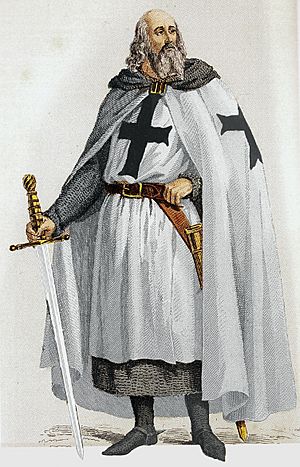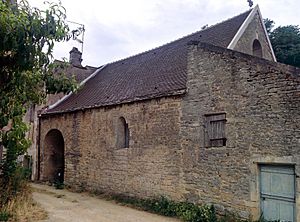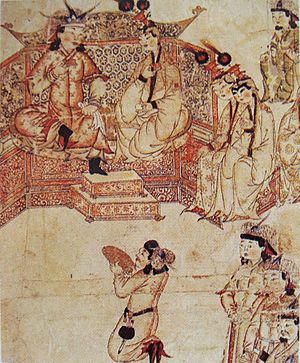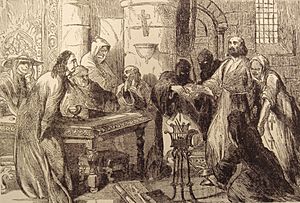Jacques de Molay facts for kids
Quick facts for kids
Jacques de Molay
|
|
|---|---|
 |
|
| 23rd Grand Master of the Knights Templar | |
| In office 1292–1312 |
|
| Monarch | King Philip IV |
| Preceded by | Thibaud Gaudin |
| Succeeded by | Order Disbanded |
| Personal details | |
| Born | c. 1240–1250 Molay, Haute-Saône, County of Burgundy |
| Died | 11 or 18 March 1314 (aged c. 70) Paris, France |
| Nationality | Franc-Comtois |
| Military service | |
| Allegiance | |
| Years of service | 1265–1314 |
| Rank | Grand Master (1292–1314) |
| Battles/wars | Siege of Ruad |
Jacques de Molay (French: [də mɔlɛ]; born around 1240–1250 – died March 11 or 18, 1314) was the 23rd and final Grand Master of the Knights Templar. He led this powerful religious military order from around 1292 until it was officially ended by Pope Clement V in 1312. Even though we don't know much about his early life, Jacques de Molay is one of the most famous Templars in history.
As Grand Master, Jacques de Molay wanted to improve the Templar Order. He aimed to help them adapt to the changing situation in the Holy Land as the Crusades were coming to an end. However, support for the Crusades in Europe was fading. At the same time, powerful people wanted to take over the Templars' wealth. King Philip IV of France, who owed a lot of money to the Templars, had Molay and many other French Templars arrested in 1307. They were forced to make false confessions. When Molay later took back his confession, King Philip had him burned on an island in the Seine River in Paris in March 1314. The sudden end of the Templars and their leader's dramatic execution made Jacques de Molay a legendary figure.
Contents
Early Life

Not much is known about Jacques de Molay's childhood. He was likely born in Molay, Haute-Saône, a region that was part of the Holy Roman Empire at the time. Today, this area is in northeastern France. Historians believe he was born between 1240 and 1250.
Like most Templar knights, he came from a family of minor or middle-ranking nobles. It is thought that he became a knight in 1265 when he was about 21 years old. He was around 70 years old when he died in 1314.

In 1265, Jacques de Molay joined the Templar Order. This happened in a chapel at the Beaune House. Humbert de Pairaud, a high-ranking Templar from France and England, welcomed him into the Order. Another important Templar, Amaury de la Roche, was also there.
Around 1270, Molay traveled to the East, also known as Outremer. This was the name for the Crusader states in the Middle East. We don't have many records of what he did during the next twenty years.
Becoming Grand Master
After the city of Acre fell to the Egyptian Mamluks in 1291, many European Crusaders, called Franks, went to the island of Cyprus. Cyprus became the main base for the remaining Kingdom of Jerusalem. It was also the starting point for any future Crusader attacks against the Egyptian Mamluks. The Mamluks were slowly taking over the last Crusader strongholds on the mainland.
Jacques de Molay was in Cyprus, along with Thibaud Gaudin, who was the 22nd Grand Master. In the autumn of 1291, a meeting was held on the island. Molay suggested making changes to the Templar Order and offered himself as a possible new leader. Gaudin died around 1292. Since there were no other strong candidates, Molay was soon chosen as the new Grand Master.
In the spring of 1293, Molay traveled to Europe to gather more support for taking back the Holy Land. He built relationships with important European leaders like Pope Boniface VIII and Edward I of England. Molay's main goals were to make Cyprus stronger and rebuild the Templar army. He managed to get permission from some rulers to send supplies to Cyprus. However, he couldn't get a firm promise for a new Crusade.
There was also talk of combining the Templars with another military order, the Knights Hospitaller. The leaders of both orders were against this idea. But the Pope kept pushing for them to merge.
Molay held two important meetings for his Order in southern France. One was in Montpellier in 1293 and another in Arles in 1296. At these meetings, he tried to make reforms within the Order. In late 1296, Molay returned to Cyprus. He had to defend the Templars against the interests of Henry II of Cyprus, the king of the island.
Crusades and Challenges
From 1299 to 1303, Molay worked on a new plan to attack the Mamluks. The idea was to have Christian military orders, the King of Cyprus, and the forces of Cilician Armenia work together. They also hoped to get help from a new ally, the Mongols of the Ilkhanate (Persia). Their goal was to fight the Egyptian Mamluks and recapture the coastal city of Tortosa in Syria.
For many years, there had been talks between the Mongols and Europeans about forming an alliance against the Mamluks. But these talks never led to success. The Mongols had tried to conquer Syria many times themselves. Each time, they were either pushed back by the Egyptian Mamluks or had to retreat because of civil wars within the Mongol Empire. For example, they had to defend against attacks from the Mongol Golden Horde in the north. In 1299, the Ilkhanate tried to conquer Syria again. They had some early success against the Mamluks in the Battle of Wadi al-Khazandar in December 1299.
In 1300, Molay and other forces from Cyprus put together a small fleet of sixteen ships. They raided the coasts of Egypt and Syria. King Henry II of Jerusalem, the king of Cyprus, led this force. His brother, Amalric, Lord of Tyre, and the leaders of the military orders were also there. An ambassador from the Mongol leader Ghazan joined them too. The ships left Famagusta on July 20, 1300. They raided cities like Rosetta, Alexandria, Acre, Tortosa, and Maraclea, before returning to Cyprus.
The Cypriots then prepared to attack Tortosa in late 1300. They sent a combined force to the island of Ruad. From Ruad, they launched raids on the mainland. The plan was to create a Templar base and wait for help from Ghazan's Mongols. However, the Mongols did not arrive in 1300. The same thing happened in 1301 and 1302. The island of Ruad was finally lost in the Siege of Ruad on September 26, 1302. This meant the Crusaders lost their last foothold near the mainland.
After losing Ruad, Molay stopped using small advance forces. Instead, he focused on getting support for a new, large Crusade. He also worked to make Templar power stronger in Cyprus. When a power struggle happened between King Henry II and his brother Amalric, the Templars supported Amalric. Amalric took the crown and sent his brother away in 1306. Meanwhile, in Europe, there was growing pressure to combine the Templars with other military orders. Some even suggested putting all orders under one king, who would then become the new King of Jerusalem.
Journey to France
In 1305, the new Pope, Pope Clement V, asked the leaders of the military orders for their thoughts on a new crusade and on merging their orders. Molay wrote his opinions on these topics in the summer of 1306. Molay was against merging the orders. He believed that having separate military orders made them stronger, as each order had slightly different goals. He also thought that if there was to be a new crusade, it needed to be a very large one, because smaller attempts had not worked well.
On June 6, 1306, the leaders of both the Templars and the Hospitallers were officially asked to come to the Pope's office in Poitiers, France. The meeting was set for November 1, 1306, but it was delayed because the Pope was sick. Molay left Cyprus on October 15, 1306, and arrived in France in late 1306 or early 1307. However, the meeting was delayed again until late May because of the Pope's illness.
King Philip IV of France owed a lot of money to the Templars. He wanted to combine the orders under his own control, hoping to become a powerful "War King." But Molay disagreed with this idea. Philip was already having problems with the Pope. He tried to tax the clergy (church officials) and wanted his own power to be higher than the Pope's. Because of this, one of Clement's earlier predecessors, Pope Boniface VIII, tried to remove Philip from the Church. But Philip had Boniface captured and accused him of heresy (going against church teachings). The elderly Boniface was rescued but died soon after from shock. His successor, Pope Benedict XI, also died quickly, possibly poisoned. It took a year to choose the next Pope, the Frenchman Clement V. Clement was under strong pressure from Philip. Clement moved the Pope's office from Italy to Poitiers, France, where Philip continued to try and control the Pope and the Templars.
The Grand Master of the Hospitallers, Fulk de Villaret, was also delayed in coming to France because he was fighting a battle at Rhodes. He didn't arrive until late summer. While waiting for him, Molay met the Pope to discuss other matters. One topic was accusations made by some former Templars. These Templars claimed there were improper things happening in the Templars' initiation ceremony. Molay had already spoken with the king in Paris on June 24, 1307, about these rumors. He felt somewhat reassured. Returning to Poitiers, Molay asked the Pope to start an investigation to quickly clear the Order's name. The Pope agreed and began an inquiry on August 24, 1307.
Arrest and Charges
There were five main accusations made against the Templars.
King Philip wanted the Templars arrested and their wealth taken. He wanted their money for his own treasury and to get rid of the huge debt he owed them. On September 14, Philip used the rumors and the ongoing inquiry to act against the Templars. He sent out a secret order to his agents across France to arrest all Templars at dawn on October 13. Molay was in Paris on October 12, where he helped carry the coffin at the funeral of Catherine of Courtenay. She was the wife of Count Charles of Valois and King Philip's sister-in-law. In a surprise raid at dawn on Friday, October 13, 1307, Molay and all the Templars in Paris were arrested. Philip then accused the Templars of heresy and many other false charges. Most of these charges were similar to ones Philip's agents had made against Pope Boniface VIII before.
During harsh questioning by the king's agents at the University of Paris on October 24 and 25, Molay confessed that the Templar initiation ritual included "denying Christ and trampling on the Cross." He was also forced to write a letter asking every Templar to admit to these actions. Because of pressure from King Philip IV, Pope Clement V ordered the arrest of all Templars throughout Christendom (Christian Europe).
The Pope still wanted to hear Molay's side of the story. He sent two cardinals to Paris in December 1307. In front of the cardinals, Molay took back his earlier confessions. A power struggle then began between the king and the Pope. It was settled in August 1308 when they agreed to divide the trials. Through a special papal order called a papal bull, the process for judging the Templars was set up in two parts. One group would judge individual Templars, and a different group would judge the Templar Order as a whole. Pope Clement called for a large church meeting, an ecumenical council, to happen in Vienne in 1310. This council would decide the future of the Templars. In the meantime, the Order's leaders, including Molay, were to be judged by the Pope.
At the royal palace in Chinon, Molay was questioned again by the cardinals. This time, royal agents were present. Molay repeated the forced confessions he had made in 1307. In November 1309, the Pope's own commission for France began its hearings. During these hearings, Molay again took back his confession. He stated that he did not agree with the accusations against his order.
Any further resistance by the Templars was stopped when Philip used the earlier forced confessions. He sentenced 54 Templars to be burned at the stake between May 10 and May 12, 1310.
The council that the Pope had called for 1310 was delayed for two more years because the trials took so long. It finally met in 1312. On March 22, 1312, at the Council of Vienne, the Order of the Knights Templar was officially ended by the Pope's order.
Death

Molay was sentenced to death along with Geoffroi de Charney in 1314. This decision came from the cardinals, not directly from King Philip the Fair. He was burned at the stake on the Ile des Javiaux, an island in the Seine River. Most historians believe he was executed on March 11, 1314, although some sources say March 18, 1314.
Chinon Parchment
In September 2001, a historian named Barbara Frale found a copy of the Chinon Parchment in the Vatican Secret Archives. This document clearly states that in 1308, Pope Clement V forgave Jacques de Molay and other Templar leaders. These leaders included Geoffroi de Charney and Hugues de Pairaud. Barbara Frale published her findings in 2004. Another Chinon parchment, dated August 20, 1308, was sent to Philip IV of France. This document, already known to historians, said that forgiveness had been given to all Templars who had confessed to heresy. It also said they were "restored to the Sacraments and to the unity of the Church."
See also
 In Spanish: Jacques de Molay para niños
In Spanish: Jacques de Molay para niños




